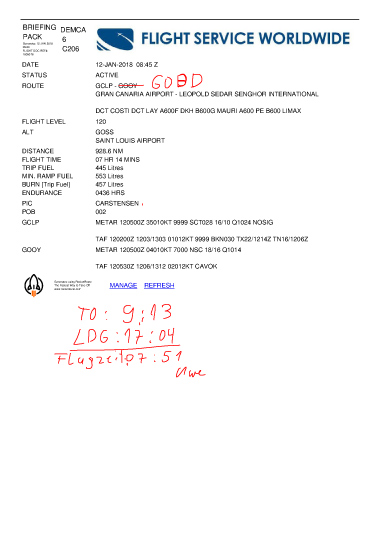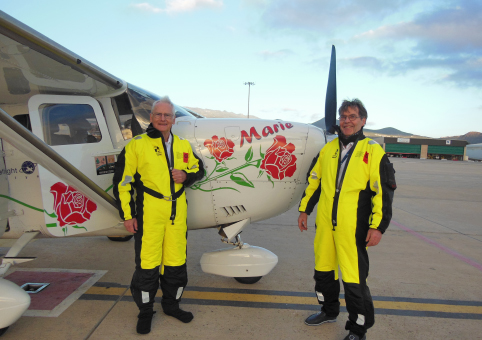Flight Log: Gran Canaria GCLP -- Dakar GOBD 12.01.2018/13.01.2018/14.01.2018

 12 January 2018, Gran Canaria — Dakar:
12 January 2018, Gran Canaria — Dakar:
After our friendly handling agent in Dakar had changed our flight plan from GOBD to GOOY airfield because GOBD apparently didn’t have a fully functional aviation fuel pump, we thought we were heading for GOOY. We agreed and once we’d put on our survival suits at the airfield in Gran Canaria and bid the handling agent a friendly farewell, we taxied to space 01 on the left according to the tower’s instructions. A minute before take-off, the tower told us that the flight plan to GOOY had been cancelled and we couldn’t take off. Once I had explained that our handling agent in Dakar had changed the airfield to GOBD and that the route in general wasn’t changing, the controller in the tower did a bit of research and two minutes later confirmed that the new flight plan had been accepted and we could after all set off for the new Blaise Diagne airfield to Dakar. We taxied onto the runway and looked forward to another enjoyable flight.
As we later discovered after landing in Dakar, it was a manual pump that wasn’t working and it was because of this that our handling agent absurdly decided to change the target airfield completely instead. And there we see that the African mindset is sometimes different. Whatever, we took off in good weather and quickly reached our cruising altitude. One of our most important tasks was to use our high-frequency equipment to get into contact with Radio Gran Canaria.
I spent roughly an hour trying to reach Radio Canaria’s frequencies on our high-frequency equipment. It didn’t work immediately. But then, after about 10 attempts I did hear a voice loud and clear on frequency 6535. Our radio communications had arrived and we were given another frequency for VHF radio communications. So it did actually work with the high-frequency equipment. The pilots were of course euphoric, which made them briefly lose touch with reality and believe that they must be on their way to Mars – as the picture shows. We found our course relatively quickly when we saw the sand of the Sahara below us two hours later. During this period, we had to eat and drink something to keep our batteries going. But even though visibility increasingly improved, we couldn’t see any camels on the Sahara sand or any oases, just sand and dried-out lakes.
Eventually we reached the border to Mauritania. During this section of the flight, Kurt had to learn a few lessons in terms of position reports. Because during the flight over the north coast of Africa, the controllers don’t have any radar and therefore constantly require reports on the flight altitude, the probable arrival time and the distance to a particular waypoint. They enter these position reports on a screen to see which planes are flying at which altitude and in what direction through their control zone.
About two hours before reaching Dakar, Marie suffered a malfunction: The temperature sensor on the engine’s cylinder 2 stopped reporting any temperatures. It’s a well-known fact that Cessna planes have a problem with temperature sensors, so we weren’t exactly surprised. We checked all the other temperatures and realised that there must be a malfunction in the temperature sensor. In the meantime, Kurt took photos of a huge oil slick, but it was difficult to get a good picture from this altitude.
The automatic airfield announcement indicated that Dakar was covered with a vast amount of smog, making visibility poor. From the plane, we couldn’t see very much except for a strip of coast. But the air traffic controllers in Dakar guided us superbly. We approached the airfield tower and started to prepare to go towards runway 01 flying with instruments. This was when the temperature display on cylinder 2 started to go mad. It showed a red bar, indicating significant excess temperature. However, all other temperature information and any noise didn’t suggest that any serious damage had been done. We landed after following the controller’s instructions for an instrument flight and couldn’t see the runway for a long time because of the smog and dust. Eventually we landed on the runway and were guided to our position by the tower with the aid of a follow-me vehicle. The handling agent and his colleagues were on hand and asked the first obligatory question as to whether we wanted to fill up the plane with fuel that evening. He emphasised the word evening because it was Friday and already quite late. Going on my previous experience however, I insisted on refuelling there and then. If the refuelling team is on hand and available on a Friday afternoon, I didn’t want to make the mistake of sending them away again because getting the same team to turn up on a Saturday or Sunday is quite an adventurous task. Which is why a team of Africans arrived half an hour later: a whole crew of 10 and a pathetic manual pump with four cannisters of aviation fuel rolled up in a bombed-out truck. The cannisters were unloaded but the manual pump had to be repaired again after they discovered that the connecting piece that goes into the cannisters wasn’t long enough and only managed to get three quarters of the cannister empty. After several attempts and repairs to the connecting piece, it was after sunset that we were then actually able to fill up our extra tank at the back of the cabin and the plane was prepared for the flight to Natal. The only additional task will be on Monday morning when we will have to check the oil level. I wanted to get into contact with Mr Müller again about the temperature sensor. Because of course we want to rule out, as far as possible, that the temperature display isn’t faulty but that there’s a malfunction in cylinder 2. I’ll be interested to see what the result of the calls will be.
Good night!
 Loading. Please wait...
Loading. Please wait...
















